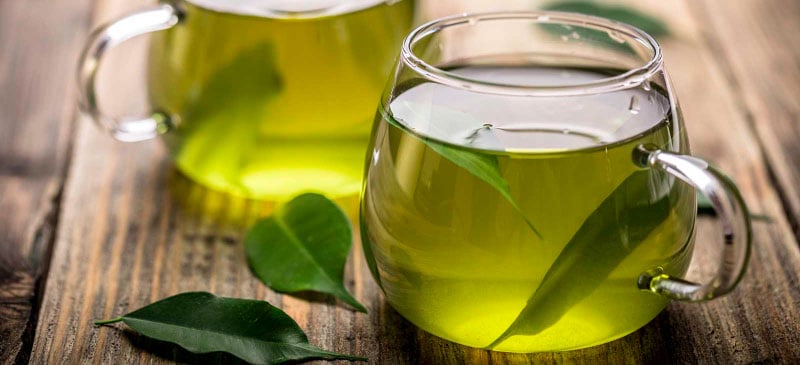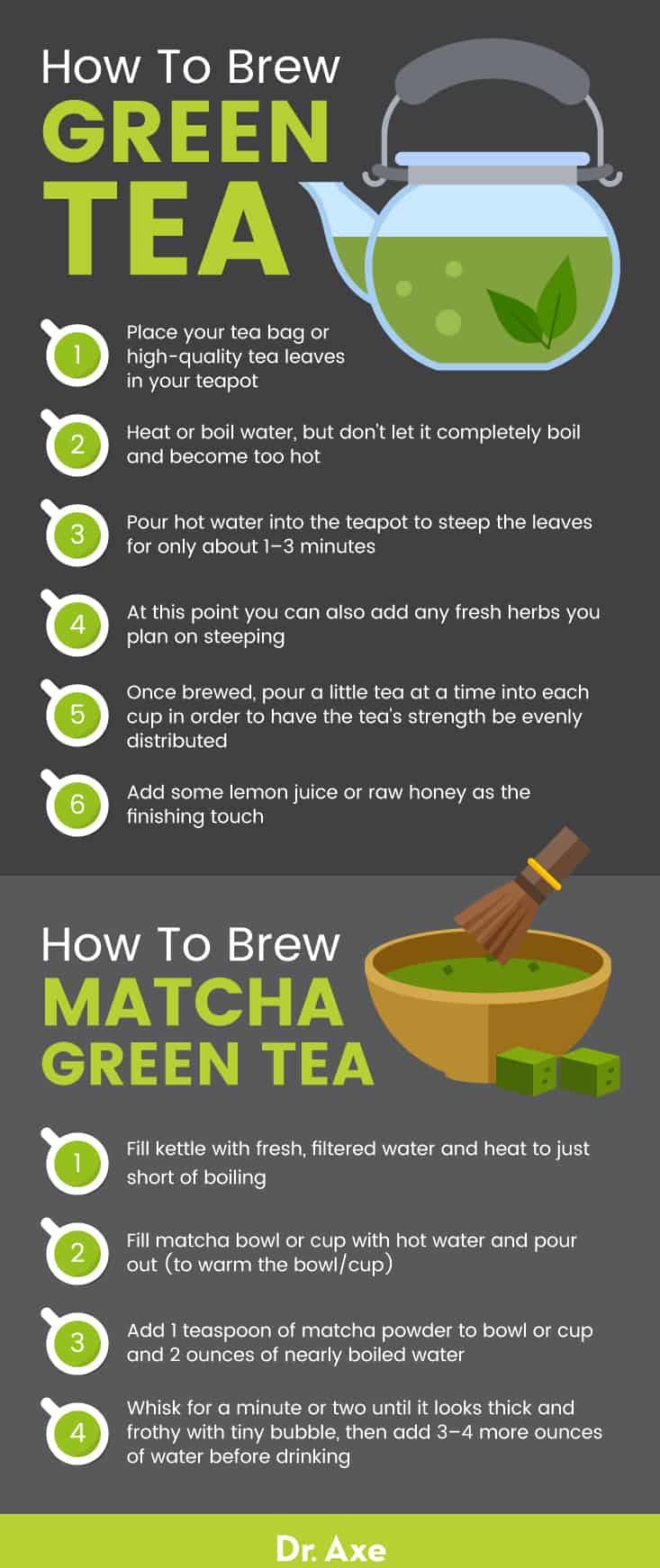Grean Tea: the Healthiest Tea with Tons of Benefits (original) (raw)
Fact Checked
This Dr. Axe content is medically reviewed or fact checked to ensure factually accurate information.
With strict editorial sourcing guidelines, we only link to academic research institutions, reputable media sites and, when research is available, medically peer-reviewed studies. Note that the numbers in parentheses (1, 2, etc.) are clickable links to these studies.
The information in our articles is NOT intended to replace a one-on-one relationship with a qualified health care professional and is not intended as medical advice.
This article is based on scientific evidence, written by experts and fact checked by our trained editorial staff. Note that the numbers in parentheses (1, 2, etc.) are clickable links to medically peer-reviewed studies.
Our team includes licensed nutritionists and dietitians, certified health education specialists, as well as certified strength and conditioning specialists, personal trainers and corrective exercise specialists. Our team aims to be not only thorough with its research, but also objective and unbiased.
The information in our articles is NOT intended to replace a one-on-one relationship with a qualified health care professional and is not intended as medical advice.
Green Tea: the No. 1 Anti-Aging Beverage?
January 30, 2023

You’ve probably heard a lot about the health benefits of drinking tea, especially the benefits of green tea, considered by many to be the ultimate “anti-aging beverage.”
In Okinawa, Japan — one of the world’s “Blue Zones” that’s associated with longevity —drinking green tea daily is considered “essential.” A popular practice is sipping on a combination of steeped green tea leaves, jasmine flowers and a bit of turmeric (turmeric tea) throughout the day.
What is green tea good for? According to dozens of studies, it’s considered one of the top healthy drinks. Regularly drinking this tea may reduce your risk of developing heart disease or Alzheimer’s, help you maintain better bone mineral density, ward off eye diseases that affect vision in older age, prevent strokes, and even extend your life.
What Is Green Tea?
What are different green teas made of exactly, and are they totally natural? Green, black and oolong teas come from the Camellia sinensis plant. Green tea consists of leaves that haven’t been fermented so they contain the highest level of antioxidants. For example, flavonoid antioxidants account for about 30 percent of the dry weight of green tea leaves.
Some of the antioxidants and healing compounds found in green tea include polyphenols, catechins and various other types of flavonoids — the same anti-aging compounds found in things like red wine, blueberries and dark chocolate. Despite that it does contain small amounts of caffeine, green tea consumption has been associated with more health benefits than even many of the healthiest foods available to us.
Studies have found that the benefits of green tea are due to the fact this tea contains more healing compounds than many other herbs, spices, fruits and vegetables, truly making it a powerful “superfood.”
Related: Guayusa: The Antioxidant-Rich Ecuadorian Herbal Tea You Should Try
1. Helps Protect Heart Health
A great deal of evidence from randomized controlled trials suggests that consumption of flavan-3-ols and anthocyanidin antioxidants, the types found in green tea, is beneficial for metabolic and cardiovascular health. When it comes to preventing many of the risk factors for heart disease, such as having high blood pressure or cholesterol levels, some evidence shows that green tea contains 10 beta-blocking compounds, seven calcium channel blockers and 16 diuretic compounds. It also has more ACE-inhibiting properties than many other plant foods that are commonly consumed, which helps increase the amount of blood your heart pumps and lowers blood pressure.
According to a study published in the journal Chinese Medicine, many of the beneficial biological effects of flavonoids on heart health seem to be due to cell-signaling effects that lower inflammation. Not only do bioflavonoids have anti-inflammatory capabilities, but they’re also antithrombogenic, antidiabetic, anticancer and neuroprotective compounds.
2. May Help Prevent Alzheimer’s or Memory Loss
In 2004, scientists at the University of Newcastle studied the effects of black and green tea on Alzheimer’s disease. In laboratory studies, both teas prevented the breakdown of acetylcholine, the neurotransmitter strongly linked with memory. The teas also inhibited enzymes known as BuChE and beta-secretase. These enzymes are found in protein deposits found in the brain of Alzheimer’s patients.
Japanese researchers published a study on green tea and its effect on the beta-amyloid protein plaques found in Alzheimer’s disease in the Journal of Nutritional Biochemistry. The protein plaques associated with Alzheimer’s disease increase brain cell damage and death due to oxidative stress. The researchers found that green tea catechins reduced the level of damaging free radicals in the brains of rats. The green tea rodents showed much less plaque-induced deficits in memory compared to rodents that didn’t receive green tea and those that were infused with beta-amyloid proteins.
Scientists have also discovered that the antioxidants flavonoids may also protect the brain from oxidative stress. The scientists extrapolated that a human would need to drink about three liters of liquid infused with 0.5 percent of the catechins to get similar effects. However, because humans ingest other antioxidants in the form of vitamins and plant polyphenols, it’s likely that a much lower quantity could be effective in protecting memory. (Ginger tea has also been found to help protect brain health.)
3. Helps Protect Brain Cells From Free Radical Damage
Salk Institute researchers found that the flavonoid epicatechin, found in blueberries, cocoa, grapes and tea, improved memory ability in mice. The researchers found that epicatechin seemed to promote blood vessel growth in the brain.
King’s College researchers found that epicatechin may protect brain cells through mechanisms unrelated to its antioxidant ability, as epicatechin is one of the few flavonoids that can cross the blood-brain barrier. The King’s College researchers reported that somehow epicatechin protects brain cells from the negative effects of beta-amyloid plaques, although the exact mechanism of how this works is still not entirely know.
4. May Help Prevent Diabetes or Insulin Resistance
Certain studies indicate that intake of flavan-3-ols and/or anthocyanidins found in green tea may improve glycemic control and help normalize blood sugar levels. Due to its anti-inflammatory properties, green tea is believed to be beneficial for those who are at-risk or diagnosed with type 2 diabetes. Green tea’s catechins, especially EGCG, appear to have anti-obesity and antidiabetic effects.
5. Promotes Bone Health
University of Hong Kong researchers published a study in the Journal of Agricultural and Food Chemistry concerning green tea and bone health. When the bone cells of rats were exposed to green tea catechins, EGC in particular stimulated an enzyme that promotes bone growth by 79 percent. The catechins also increased bone mineralization and weakened the activity of cells that reabsorb bone rather than form it.
6. Prevents Eye Disease and Protects Vision
One study that was published in the the Journal of Agricultural and Food Chemistry investigated the effects of catechins on eye diseases and found that consuming more catechins may help protect the eyes from oxidative damage and vision loss.
Scientists involved in the study found evidence that catechins can pass from the digestive tract of rodents to the tissues of their eyes and reduce oxidative stress for up to 20 hours after ingestion.
7. May Reduce Your Appetite
Does green tea really burn fat, and will drinking green tea help you lose more weight? According to some research findings, consuming antioxidants found in green tea, especially catechins and the compound called EGCG, may promote metabolic health and modestly prevent weight gain. When 11 studies and articles were included in one 2009 meta-analysis that was published in the International Journal of Obesity, researchers found that “catechins or an epigallocatechin gallate (EGCG)-caffeine mixture have a small positive effect on weight loss and weight maintenance.”
Overall, EGCG’s effects remain somewhat controversial; some studies have found only modest effects on metabolism, while others have found that consuming more EGCG alone without other lifestyle changes does not do anything significant to improve body weight.

Types
There are a wide variety of green teas available around the world. The type called sencha is the most popular and usually the easiest to find. Other lesser known varieties of green tea include:
- Fukamushi Sencha (or Fukamushi Ryokucha)
- Gyokuro
- Kabusecha
- Matcha
- Tencha
- Genmaicha
- Hojicha
Matcha Green Tea
Matcha green tea is a high-grade, finely ground, concentrated green tea. It’s been traditionally used in Japanese tea ceremonies for hundreds of years and has recently gained notoriety for its high antioxidant content. When you drink matcha tea, you drink the actual tea leaves, which have been ground up. This allows you to obtain even more nutrients compared to drinking steeped green tea.
Tea plants that are specifically grown and used to make matcha are also typically shaded for two weeks to increase chlorophyll levels before the leaves are picked, further boosting concentration of healthy compounds. Matcha green tea tends to be more expensive than buying tea leaves for steeping, but a little goes a long way. Matcha is usually available in powder form and is a good choice for adding green tea’s taste and the benefits of green tea to recipes like smoothies, baked goods or ice cream.
Green Tea vs. Black Tea
- Both green and black tea share many of the same benefits, considering they come from the same plants. The processing of different teas results in the different colors, flavors and health benefits of green tea and black tea. Green tea leaves are dried for a shorter time than black tea leaves before processing, so they keep their greener color.
- Compared to green tea, black tea is more processed. Green tea gets dried and undergoes a pan-frying or steam-heating process depending on the variety. Black tea is made using leaves that have oxidized, which means they were purposely permitted to wilt and brown after picking.
- Green tea has slightly more antioxidants compared to black tea, although both are still great sources. The ORAC value (antioxidant content) of brewed black tea is 1,128 while green tea is slightly higher at 1,253. Black tea and green tea both contain antioxidants, including polyphenols. Some research shows that green tea contains more than four times the catechins that black tea does. Both types can contribute antioxidants to your diet and have been shown to have antiviral, anti-inflammatory, detoxifying and immune-stimulating effects.
- In terms of their caffeine content, green tea is usually lower in caffeine than black tea. Both have less caffeine than coffee, yerba mate tea or energy drinks, making them suitable for people who can’t tolerate drinking much caffeine.
Nutrition Facts
Flavan-3-ols, the type of flavonoids found in green tea and other teas, provide many of the anti-aging effects of green tea. Catechins in various types of teas are the polyphenols that seem to have the most potent antioxidant effects, according to Natural Standard, the leading and most respected reviewer of herbal compounds. Specific flavan-3-ols found in green tea include monomers (catechins) called:
- Epicatechin
- Epigallocatechin
- Gallocatechin
- Gallate derivatives
A well-known compound found in green tea is called EGCG (which stands for epigallocatechin-3-gallate). EGCG is associated with enhanced metabolic activities that may prevent weight gain or assist with weight maintenance. Some of the ways that EGCG seems to work is by boosting thermogenesis (the body producing heat by using energy) and suppressing appetite, although not every study has found evidence that these effects are substantial. (This is also why green tea extract is used in many thermogenic supplements.)
Green tea also contains many other protective compounds, including:
- Linoleic acid
- Quercetin
- Aginenin
- Methylxanthines, including caffeine, theobromine and theophylline
- Many different amino acids and enzymes (proteins make up about 15 percent to 20 percent of the leaves’ dry weight)
- Carbohydrate molecules, such as cellulose, pectins, glucose, fructose and sucrose
- Small amounts of minerals and trace elements like calcium, magnesium, chromium, manganese, iron, copper and zinc
- Small amounts of chlorophyll and carotenoids
- Volatile compounds like aldehydes, alcohols, esters, lactones and hydrocarbons
Some of the benefits of green tea associated with the consumption of these compounds include reduced allergies, eye health and better vision, skin health, improved immune function, enhanced endurance, and protection from free radical damage and cancer.
How to Use
Most experts recommend drinking about three to four cups per day for the most anti-aging benefits of green tea, but even drinking one to two cups is a step in the right direction. There are some ways to spice up your green tea.
The standard way to brew green tea:
- Place your tea bag or high-quality tea leaves (purchase organic from a reputable company for the best tea) in your teapot.
- Heat or boil water, but don’t let it completely boil and become too hot, as this can destroy some of the delicate compounds found in green tea leaves. The “ideal” temperature for brewing green tea is between 160 degrees Fahrenheit to 180 degrees F (traditionally standard Chinese green teas brew at a slightly higher temperatures). Pour hot water into the teapot to steep the leaves for only about 1–3 minutes. Larger leaves need more time to steep than finer, smaller leaves. At this point you can also add any fresh herbs you plan on steeping.
- Once brewed, pour a little tea at a time into each cup in order to have the tea’s strength be evenly distributed. At this point, you can add some lemon juice or raw honey as the finishing touch.
Because it’s used somewhat differently than regular green tea, directions for making matcha green tea are found below (note that directions can vary, so it’s best to read the label of the product you purchase):
- Fill kettle with fresh, filtered water and heat to just short of boiling.
- Fill matcha bowl or cup with hot water and pour out (to warm the bowl/cup).
- Add 1 teaspoon of matcha powder to bowl or cup and 2 ounces of nearly boiled water.
- Whisk for a minute or two until it looks thick and frothy with tiny bubble, then add 3–4 more ounces of water before drinking.

History
Green tea has been consumed in Asia, particularly in China, for thousands of years. Records show that it was a common beverage and cooking ingredient 3,000 years ago in parts of Southwest China, before spreading over the following centuries to India and then Japan.
From the 3rd century through the 6th century, this tea was mostly considered a “luxury item” before new techniques for drying and distributing green tea led to more mass production and availability among the public. According to the Teavivre, a tea company, during the time of the Song Dynasty in China (AD 960–1279), “tea drinking had become an integral part of the daily life of all Chinese, in a similar way to how afternoon tea became ingrained in the English culture. The use and production of so-called ‘tribute teas’ — those produced to be presented to the emperor and other high officials — became an important part of royal culture and a source of government taxation.”
Today, an estimated 2.5 million tons of tea leaves are produced each year throughout the world, with 20 percent of that being green tea. Green tea didn’t become popular or widely distributed outside of Asia until about the early 1900s. China, other countries in Asia, countries in North Africa, the United States and Europe currently consume the most green tea worldwide.
Risks and Side Effects
It’s important to point out that while it might be very beneficial, drinking green tea alone likely won’t improve your life span or protect you from disease. Research suggests that a combination of lifestyle components account for the health benefits observed in people that drink tea.
The problem with many studies that investigate the effects of green tea is that they are population studies rather than controlled clinical studies. In many of these studies, other lifestyle factors and habits besides drinking green tea are not well-controlled, so it’s difficult to draw conclusions. Overall, studies have found a great number of health benefits of green tea, especially as it relates to anti-aging, but the bottom line is that the quality of your overall diet is really what’s most important.
There are also several harmful effects of green tea over-consumption that are possible. These include consuming tainted supplements marked as green tea extract, high caffeine consumption, consuming aluminum, and the effects of tea polyphenols on iron bioavailability. Green tea extracts should not be taken by patients suffering from renal failure, liver disease, heart conditions or major cardiovascular problems without supervision from a doctor. People sensitive to caffeine should be careful of their intake. Pregnant and breast-feeding women should drink no more than one or two cups per day, as some research shows that more caffeine than this amount may interfere with normal heart rhythms.
Final Thoughts
- Green tea comes from the Camellia sinensis plant and consists of leaves that haven’t been fermented, allowing them to retain high levels of antioxidants.
- Antioxidants and other beneficial compounds found in this tea include flavonoids and catechins like EGCG, quercetin, linoleic acid, theobromine and theophylline. These provide many of the benefits of green tea.
- Some of the anti-aging effects and benefits of green tea include reduced inflammation, protection against heart disease, liver disease, diabetes and Alzheimer’s, and potentially help with weight maintenance and preventing cancer.
- There are many ways to enjoy this beverage in order to take advantage of the many benefits of green tea.
- Other teas that feature health benefits include white tea, chai tea, jasmine tea, rooibos tea, dandelion tea, linden tea and pu-erh tea.